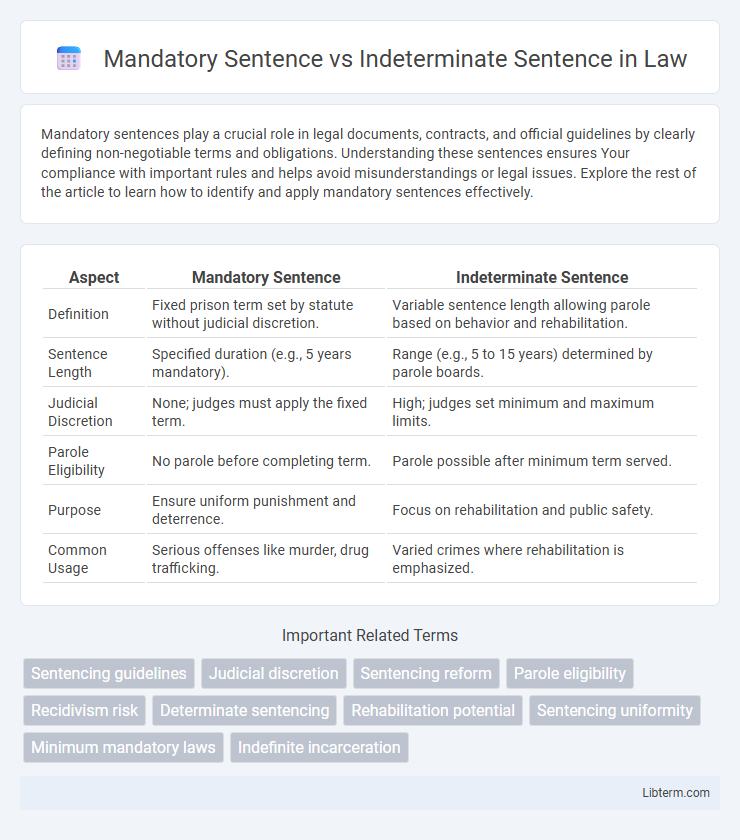Mandatory sentences play a crucial role in legal documents, contracts, and official guidelines by clearly defining non-negotiable terms and obligations. Understanding these sentences ensures Your compliance with important rules and helps avoid misunderstandings or legal issues. Explore the rest of the article to learn how to identify and apply mandatory sentences effectively.
Table of Comparison
| Aspect | Mandatory Sentence | Indeterminate Sentence |
|---|---|---|
| Definition | Fixed prison term set by statute without judicial discretion. | Variable sentence length allowing parole based on behavior and rehabilitation. |
| Sentence Length | Specified duration (e.g., 5 years mandatory). | Range (e.g., 5 to 15 years) determined by parole boards. |
| Judicial Discretion | None; judges must apply the fixed term. | High; judges set minimum and maximum limits. |
| Parole Eligibility | No parole before completing term. | Parole possible after minimum term served. |
| Purpose | Ensure uniform punishment and deterrence. | Focus on rehabilitation and public safety. |
| Common Usage | Serious offenses like murder, drug trafficking. | Varied crimes where rehabilitation is emphasized. |
Understanding Mandatory Sentences
Mandatory sentences require offenders to serve a fixed period of incarceration determined by law, eliminating judicial discretion in sentencing length. These sentences are commonly applied in cases involving serious crimes such as murder, where statutes prescribe minimum terms to ensure consistent punishment and public safety. Understanding mandatory sentences is essential for grasping how legal systems enforce uniform penalties and limit variability in criminal justice outcomes.
What Are Indeterminate Sentences?
Indeterminate sentences are prison terms without a fixed length, allowing parole boards to decide the release date based on an inmate's behavior and rehabilitation progress. These sentences typically have a minimum and maximum range, offering flexibility to tailor the punishment to the offender's circumstances and societal safety. Indeterminate sentencing contrasts with mandatory sentences, which require a set period of incarceration without discretion for early release.
Legal Foundations of Sentencing Types
Mandatory sentences require judges to impose a predetermined punishment based on statutes without discretion, ensuring uniformity and adherence to legislative directives. Indeterminate sentences grant judges flexibility to set a minimum and maximum duration, allowing parole boards to decide actual release dates based on rehabilitation and behavior. These sentencing types are grounded in legal principles balancing legislative intent for consistency with judicial discretion for individualized justice.
Key Differences: Mandatory vs Indeterminate Sentences
Mandatory sentences require the offender to serve a fixed, predetermined prison term without the possibility of parole, ensuring a consistent punishment for specific crimes. Indeterminate sentences provide a range or minimum and maximum time frame, allowing parole boards to decide the actual release date based on the inmate's behavior and rehabilitation progress. The key difference lies in mandatory sentences offering no discretion in duration, while indeterminate sentences allow individualized release decisions within set limits.
Impact on Judicial Discretion
Mandatory sentences limit judicial discretion by imposing fixed penalties for specific offenses, eliminating the judge's ability to tailor punishment based on case-specific factors. Indeterminate sentences enhance judicial discretion, allowing judges to adjust the length and nature of the sentence according to the offender's rehabilitation needs and circumstances of the crime. This flexibility can lead to more individualized justice but may also result in inconsistent sentencing outcomes across similar cases.
Effects on Rehabilitation and Recidivism
Mandatory sentences limit judicial discretion, often leading to uniform punishments that may neglect individual rehabilitation needs, potentially increasing recidivism rates due to lack of tailored interventions. Indeterminate sentences enable judges to consider offender-specific factors, allowing for rehabilitation-focused sentencing that adapts to an individual's progress, which can reduce the likelihood of reoffending. Research indicates that flexible sentencing policies, as seen in indeterminate sentences, support better reintegration outcomes and lower recidivism compared to the rigid structure of mandatory sentences.
Arguments for Mandatory Sentencing
Mandatory sentencing ensures uniformity in punishment by eliminating judicial discretion, thereby promoting consistency and predictability in the legal system. It serves as a deterrent by imposing strict penalties for specific offenses, reinforcing societal norms and public safety. Critics argue it may lead to unjust outcomes, but proponents emphasize its role in addressing crime severity and protecting communities through clear legal consequences.
Arguments for Indeterminate Sentencing
Indeterminate sentencing allows for tailored rehabilitation by giving parole boards discretion to release inmates based on their progress, promoting individualized justice. It reduces prison overcrowding by enabling earlier release of reformed offenders, which is supported by studies showing lower recidivism rates compared to mandatory sentences. Critics argue that mandatory sentencing removes judicial discretion, but indeterminate sentencing aligns punishment with offender rehabilitation and public safety needs.
High-Profile Cases Illustrating Each Approach
High-profile cases such as the trial of Timothy McVeigh, where a mandatory sentence was imposed for the Oklahoma City bombing, illustrate strict judicial adherence to legally fixed penalties regardless of mitigating factors. In contrast, indeterminate sentencing, exemplified by the sentencing of Bernie Madoff, allows judges discretion to assign a range of years based on factors like the defendant's background and the severity of the crime. These cases highlight the judicial system's balancing act between uniformity in justice and personalized sentencing tailored to individual circumstances.
Future Trends in Sentencing Laws
Future trends in sentencing laws show a shift from mandatory sentences, which prescribe fixed penalties for certain offenses, towards indeterminate sentences that allow for more judicial discretion based on rehabilitation and risk assessment. Advances in predictive analytics and risk assessment tools are increasingly influencing judges to tailor sentences that better balance public safety with offender reintegration. Legislative reforms also emphasize flexible sentencing frameworks to reduce prison overcrowding and promote restorative justice initiatives.
Mandatory Sentence Infographic

 libterm.com
libterm.com